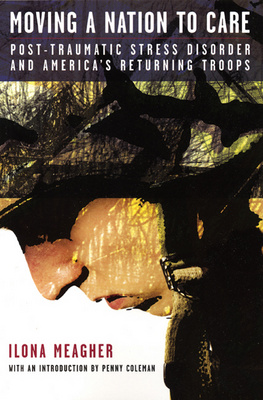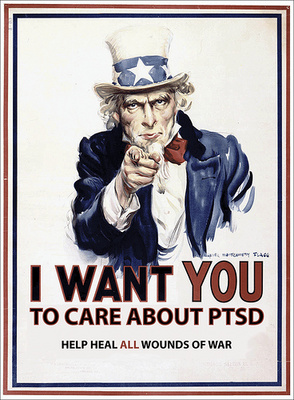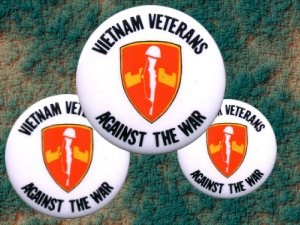
This Special Report is a follow up of a feature article on a related post from Gordan Duff way back in January 2009 – PTSD ABUSES CHALLENGE NEW VA LEADERSHIP
Though the graphic shows Ilona Meagher’s eye opening book about PTSD and our All Volunteer Force of the 21st Century, Moving a Nation to Care, (< LINK) I also found this insight by Ray Parrish (< LINK see other articles mentioning Ray Parrish) to be beneficial in helping Veterans, our active duty, Guard troops, and our families to better understand how this number game relates to applying to have one’s rating increased and timeframes involved.
First, let me say that during my search for material on PTSD and the VA Claims process, it was not surprising to note that the Stolen Valor image of the successful Vet over coming all obsticles to PTSD, meaning successful, and Republican Vets like I once was, still linger on, and to a large extend THAT STEREOTYPE of the successful Vets beating PTSD as if there were a cure for it is what hold most tradional VSOs from dealing seriously with PTSD.
That said, do a google of PTSD success stories and note that the vast majority of these success stories come from Pentagon sources. The vast majority of PTSD success stories come from Obama’s Defense Department, especially the Army that does more to discourage troops from seeking treatment let alone becoming Vets.
The Pentagon by definition has no choice but to play the same role in downplaying the impact of PTSD that it did during the Vietnam War, and change in administrations from Republican to Democrats virtually changes nothing at the Pentagon.
Most everything I found written about PTSD and the VA Claims system debunks what right-wing Vets have written (Stolen Valor) and claimed about PTSD and the liberal VA system. The very notion that any Veteran can scam the VA system and quick at that is nothing but one more Stolen Valor myth. How any fake Veterans can get by the VA system is beyond me.
It may or may not be a given that the vast majority of Veterans with combat experience are robots (emotionless) who are not affected by exposure to combat or never ending deployments but to say we are would, well be a myth.
To demonize, or stereotype, and make a myth out of any Veteran faking PTSD or the homeless Vet problem being insignificant in comparison to all Vets who served verges on the criminal and is irrelevant to the number of cases that can’t get into the VA system let alone out of the Pentagon.
 What does a book and notion written about Vietnam Vets have to do with our younger generation? EVERYTHING!!!
What does a book and notion written about Vietnam Vets have to do with our younger generation? EVERYTHING!!!
Robert L. Hanafin
Major, U.S. Air Force-Retired
Nope, I do not get VA disability for PTSD, I’m a successful Vet!
PS: Can any reader who has dealt with PTSD point me to any book listing for treatment of PTSD that includes Stolen Valor, I challenge you to show us one outside of NewsMax or Military.com
I seriously say STAY away from books written about PTSD and the Vietnam War and stick to books like Ilona’s that touches on valuable lessons learned in the War at Home to get PTSD recognized, but forcuses primarily on returning Iraq and Afghanistan Vets.
The VA’s Number Game with PTSD Ratings by Ray Parrish, VVAW Vet Counselor.
The VA determines rating for PTSD by using their "Schedule for Rating Disabilities," found at 38CFR, part. 4. (< Link) Without getting bogged down trying to figure out what CFR means let’s say it stands for Criteria for Rating Disabilities (CFR, hum that’s logical Spock) Unlike the criteria from the DSM (< Link here we go again – The Diagnostic and Statistical Manual of Mental Disorders (DSM) used to confirm a diagnosis of PTSD, the rating schedule doesn’t list the symptoms of PTSD, rather it looks at the impact that the symptoms have on the veteran’s "occupational and social functioning." (Simple put your ability to be employed or unemployability).
So when appealing a percentage assigned in a VA rating decision, your treating therapist or doctor can (and should) use the language from the rating formula and say which paragraph most closely approximates the severity of the veteran’s PTSD. Please note their use of adjectives indicating degrees, such as, occasional or most. Also note their use of difficulty versus inability (these are ultimately determining factors that go beyond the Doc you are seeing to the Regional Office adjudicators. Major Hanafin)
0% – A mental condition had been formally diagnosed, but symptoms are not severe enough either to interfere with occupational and social functioning or to require continuous medication.
10% – Occupational and social impairment due to mild or transient symptoms which decrease work efficiency and ability to perform occupational tasks only during periods of significant stress, or; symptoms controlled by continuous medication.
30% – Occupational and social impairment with occasional decrease in work efficiency and intermittent periods of inability to perform tasks (although generally functioning satisfactorily, with routine behavior, self-care, and conversation normal), due to such symptoms as: depressed mood, anxiety, suspiciousness, panic attacks (weekly or less often), chronic sleep impairment, mild memory loss (such as forgetting names, directions, recent events).
50% – Occupational and social impairment with reduced reliability and productivity due to such symptoms as: flattened affect; circumstantial, circumlocutory, or stereotyped speech (meaning one sounds like they are on speed but they are not. This is a natural and physical outward expression of a chemical imbalance in your brain. An aspect that might appear most frequent in those with TIB ); panic attacks more than once a week; difficulty in understanding complex commands; impairment of short-and long term memory (e.g., retention of only highly learned material, forgetting to complete tasks); impaired judgment; impaired abstract thinking; disturbances of motivation and mood; difficulty in establishing and maintaining effective work and social relationships. (This goes beyond hard to get along with).
7 0% – Occupational and social impairment, with deficiencies in most areas, such as work, school, family relations, judgment, thinking, or mood, due to such symptoms as: suicidal ideation; obsession rituals which interfere with routine activities; speech intermittently illogical, obscure, or irrelevant; near-continuous panic or depression affecting the ability to function independently, appropriately and effectively; impaired impulse control (such as unprovoked irritability with periods of violence); spatial disorientation; neglect of personal appearance and hygiene; difficulty in adapting to stressful circumstances (including work or a work like setting); inability to establish and maintain effective relationships.
0% – Occupational and social impairment, with deficiencies in most areas, such as work, school, family relations, judgment, thinking, or mood, due to such symptoms as: suicidal ideation; obsession rituals which interfere with routine activities; speech intermittently illogical, obscure, or irrelevant; near-continuous panic or depression affecting the ability to function independently, appropriately and effectively; impaired impulse control (such as unprovoked irritability with periods of violence); spatial disorientation; neglect of personal appearance and hygiene; difficulty in adapting to stressful circumstances (including work or a work like setting); inability to establish and maintain effective relationships.
100% – Total occupational and social impairment, due to such symptoms as: gross impairment of thought processes or communication; persistent delusions or hallucinations; grossly inappropriate behavior; persistent danger of hurting self or others; intermittent inability to perform activities of daily living (including maintenance of minimal personal hygiene); disorientation to time or place; memory loss for names of close relatives, own occupation, or own name.
About the Author: Ray Parrish (Sgt., U.S. Air Force, 72-75) is Vietnam Veterans Against the War (VVAW) Military/Veteran Benefit Counselor and mentor to Iraq Veterans Against the War (IVAW) seeking VA benefits.
Robert L. Hanafin
Major, U.S. Air Force-Retired
Life Member, VVA, DAV
Member, VVAW
Readers are more than welcome to use the articles I’ve posted on Veterans Today, I’ve had to take a break from VT as Veterans Issues and Peace Activism Editor and staff writer due to personal medical reasons in our military family that take away too much time needed to properly express future stories or respond to readers in a timely manner.
My association with VT since its founding in 2004 has been a very rewarding experience for me.
Retired from both the Air Force and Civil Service. Went in the regular Army at 17 during Vietnam (1968), stayed in the Army Reserve to complete my eight year commitment in 1976. Served in Air Defense Artillery, and a Mechanized Infantry Division (4MID) at Fort Carson, Co. Used the GI Bill to go to college, worked full time at the VA, and non-scholarship Air Force 2-Year ROTC program for prior service military. Commissioned in the Air Force in 1977. Served as a Military Intelligence Officer from 1977 to 1994. Upon retirement I entered retail drugstore management training with Safeway Drugs Stores in California. Retail Sales Management was not my cup of tea, so I applied my former U.S. Civil Service status with the VA to get my foot in the door at the Justice Department, and later Department of the Navy retiring with disability from the Civil Service in 2000.
I’ve been with Veterans Today since the site originated. I’m now on the Editorial Board. I was also on the Editorial Board of Our Troops News Ladder another progressive leaning Veterans and Military Family news clearing house.
I remain married for over 45 years. I am both a Vietnam Era and Gulf War Veteran. I served on Okinawa and Fort Carson, Colorado during Vietnam and in the Office of the Air Force Inspector General at Norton AFB, CA during Desert Storm. I retired from the Air Force in 1994 having worked on the Air Staff and Defense Intelligence Agency at the Pentagon.
ATTENTION READERS
We See The World From All Sides and Want YOU To Be Fully InformedIn fact, intentional disinformation is a disgraceful scourge in media today. So to assuage any possible errant incorrect information posted herein, we strongly encourage you to seek corroboration from other non-VT sources before forming an educated opinion.
About VT - Policies & Disclosures - Comment Policy



